Recently many people have been posting articles about the most environmentally friendly village in Japan, Kamikatsu, saying wouldn’t it be good if there was something like this in China?
Did you know that there is also an environmentally friendly village in Beijing? It’s Changping’s Xinzhuang Village (辛庄村). In this village, not only do they practice clean environmental protection and no littering, there is also a vegetarian restaurant and every first Saturday of the month there is an environmental market! Join us and experience the village with us!
Guests are welcomed to the village to the sound of the African drum music which accompanies you around the market. Even though the market is not completely vegan, most of the products are vegetarian and plant-based foods.

When you visit remember to bring the five treasures of environmental practice: reusable bags, lunch boxes, reusable water bottles, washable napkins and non-disposable cutlery! Otherwise you won’t be able eat all of the affordable, tasty treats! Only 1RMB for a vegetable baozi, it really is great value for money; if you arrive late, there’ll be nothing left. They even have vegan snacks.
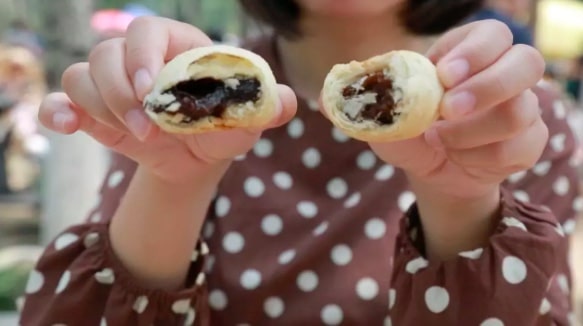
The people at the market, whether it be the elderly or the young, all have a strong environmental awareness, most of them walking around the market with their own bowls and food containers. There is a real sense of community.
Many of the stalls have small signs telling the buyers the types of waste produced by the products being sold.
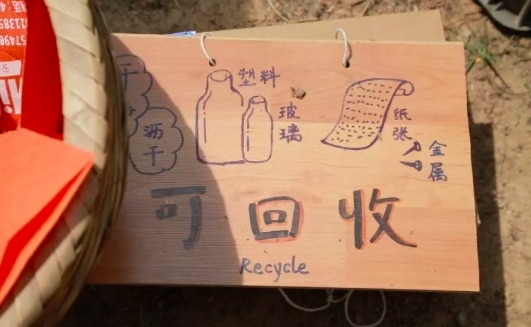
The market doesn’t only sell food but also has a lot of artistic products, with many artists selling their unique products. There are even people who sell their unwanted belongings in second-hand sales. Here you can exchange 5 kgs of old books for a potted strawberry plant!
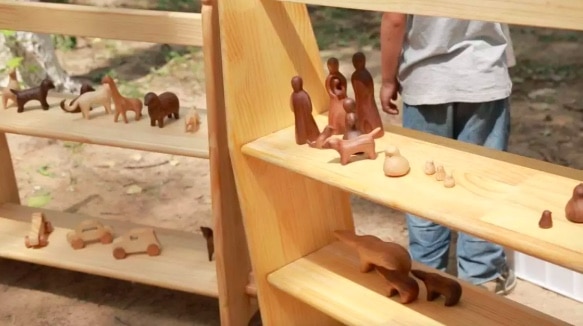
There is also a “recycling heaven”, where waste products can be sorted into boxes of 60 different types! If you don’t know which classification your waste should go in, there are volunteers that can help you and teach you about the different types of waste.
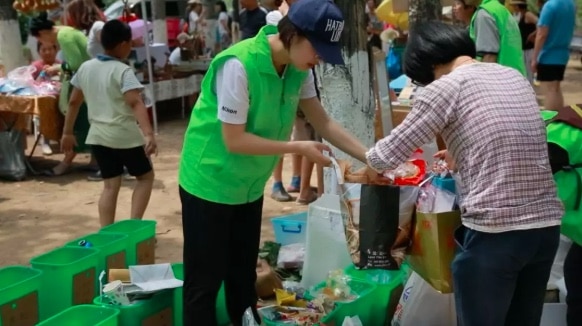
After browsing the market for a while a woman started to ring a bell calling the children to “story time”. We later found out that this woman is Yang Jing, one of the “seven maids from heaven” (七仙女) that founded the environmental village. These seven heavenly maids are seven mothers of students from the NanShan School of Art, who founded the village and created an amazing community through a wish to protect the environment.
Yang Jing told us a little about the history of the village: “in reality this environmental village is reliant on the migration of outsiders; lots of artists live here because it is close to the Nanshan School of Art, lots of parents moved here too, and as the number of migrants grew, so did the amount of rubbish and waste, to the point where it was impossible for the little village to cope. At this point we started to think of possible ways to mitigate the issue, and with the support of the local residents and committee, we decided to make an agreement to see if this solution could work.”
The planning of this project started in March 2016, and it was launched on the 9th of June, promoting and practicing “net plastic production environmental protection” (not using new plastic bags or disposable plastic products), not littering and sorting waste. Over the last two years, even though the village has still to achieve zero waste, the results are still very good and have influenced many people to participate in environmental protection.
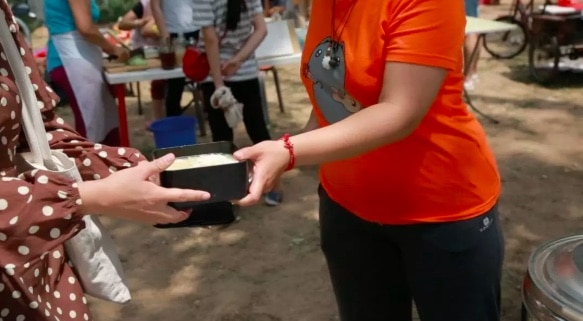
The market began in April last year, with the aim of allowing people to experience the joys of environmental protection and awareness through the market. Even though the market isn’t very big, there is a real sense of community.
Our next stop was the village itself. The first thing we noticed was how clean it was, and even though there wasn’t a single rubbish bin to be seen there was still no litter on the ground. Instead flowers grew all around the village!
On the walls there were big signs indicating the different divisions of waste and recycling. Other signs teach the residents how to create natural fertilisers with their waste.

We met a resident who has been living there for five years with his wife and children, and has turned his home into a seasonal veterinarian cooking experience called XinXiangYuan (心香园). If you want to try seasonal vegetarian food you need to book in advance.

In his home the potted plant on the dining table is a big head of cabbage, and the napkin box is made from recycled children’s clothes. We asked the family what had changed in their life since moving here five years ago, and his wife said “it’s just like this recycled napkin box, before when something got old we would throw it away, now when we see old things we think of ways to use them again and make something fun. Life here is much more relaxed than in the city, I feel like I have more and more time everyday.”
Our next stop took us to the vegetarian restaurant. We’d heard of the famous Yiputi (一菩提) before and heard of the female monk founder and artist chef. Even from the outside you can tell the food will be clean and fresh.
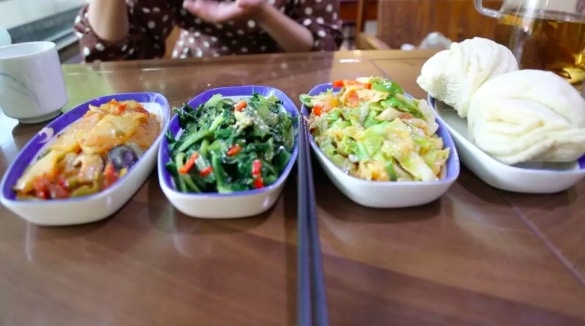
Although the restaurant is in a gallery it still has a family feel, and the vegetarian meal is truly delicious.
After lunch we went to the home of the director of the “What is food?” (何以为食?) documentary, Jian Yi, who lives in the village. Here he teaches the children of the village how to film documentaries.
Jian Yi moved here over a year ago with the original purpose of being in a more convenient location to send his child to the Nanshan School of Art, but as he said “originally we came here to raise our child, but now we find we are growing up with him too, experiencing the real purpose of life”
His house is built with his child in mind, with play areas in the garden and an allotment too, with many different types of vegetable and fruit plants. He said: “when we lived in the city all our son was interested in was things related to the city, like cars and buses, but now here, he uses his imagination to play”.

Jian Yi told us that every house here has three different rubbish bins to divide up the waste into compostable waste, non-compostable but recyclable waste and non-compostable and non-recyclable waste. All other toxic waste, such as batteries and plastic packaging, have to be collected and disposed of at the monthly market. Every morning at 7:30 and every evening at 17:30 a recycling car drives around the village to collect the waste. There are also bins for cloths recycling. The village even has its own waste dividing plant.
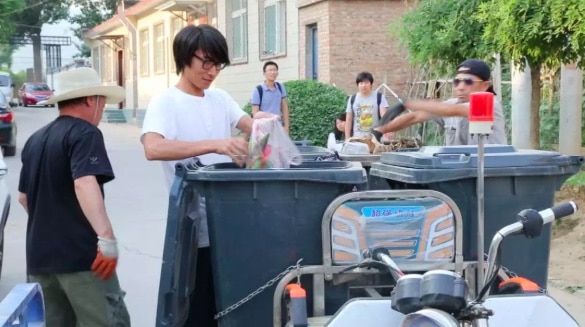
After a day of visiting the village, we really didn’t want to leave anymore.
How to get to the environmental village:
By Public Transport: ChangPing line, exit C at BeiShaoWa (北邵洼), take bus number 80 at the crossroad and get off at Taolincun (桃林村), then cross the bridge to the south bank of the river and go east along the small road until you get to a tall forest on the side of the road, and that’s the environmental village.
By car: Input Xinzhuang Village, Xingshou Town, Changping District (昌平区 兴寿镇 辛庄村) into a SatNav, along the river, the east entrance of the village is next to a tall forest.
Don’t forget: the environmental market is on the first Saturday of every month starting at 9:00 in the morning!




